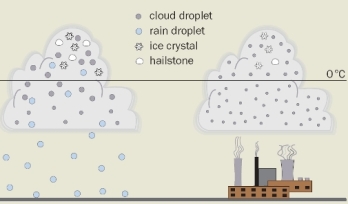| | 08 March, 2007
| | Pollution shown as cutting rainfall in hilly areas | |
 | | Illustration shows (at left) a cloud with normal foundation of rain droplets, while at right the droplets do not form readily because of the small particles caused by pollution. |
|
Jerusalem, March 7, 2007 -- Manmade climate change due to pollution seriously inhibits precipitation over hills in semi-arid regions, a phenomenon with dire consequences for water resources in the Middle east and many other parts of the world, a study by a Chinese-Israeli research team, led by Prof. Daniel Rosenfeld of the Hebrew University of Jerusalem, has shown.
The Chinese and Israeli researchers showed that the average precipitation on Mount Hua near Xian in central China has decreased by 20 percent along with increasing levels of manmade air pollution during the last 50 years. The precipitation loss was doubled on days that had the poorest visibility due to pollution particles in the air. This explains the widely observed trends of decrease in mountain precipitation relative to the rainfall in nearby densely populated lowlands, which until now had not been directly ascribed to air pollution.
The research study, published in the current issue of the journal Science, is titled “Inverse Relations between Amounts of Air Pollution and Orographic Precipitation” and was written by Prof. Rosenfeld of the Hebrew University’s Ring Department of Atmospheric Sciences, Jin Dai and others from the Meteorological Institute of Shaanxi Province, China, and Zhanyu Yao of the Chinese Academy of Meteorological Science.
These findings highlight the threat to vital water resources in polluted regions of the world where hilly-area precipitation makes a significant contribution to the regional water supply, as in the southwestern U.S. central and northern China, and the Middle East. The importance of that is underlined by the realization that it is not high temperatures due to global warming but rather the lack of water that makes a region into an unlivable desert.
The authors studied observations of precipitation and visibility starting in 1954 at the top of Mount Hua. They linked the decreasing visibility at its over two-kilometer-high summit with increasing air pollution particles that reach to the clouds. They were able to show that the trend of higher concentrations of these fine, airborne, pollutants (aerosols) is responsible for the observed decreasing trend of mountain precipitation. This is the first time that this link has been demonstrated so conclusively.
The precipitation inhibition process occurs as water vapor condenses on the pollution particles and creates a cloud with a large number of drops that are so small that they float with the air and are slow to coalesce into raindrops or to freeze into sleet and snowflakes. This slowing translates into a net loss of precipitation when the cloud “lifetime” is shorter than the time necessary to release its water. This is the case for clouds that form when they ascend across a ridge and then descend and evaporate on the downwind side.
By making use of precipitation and visibility records that show a direct causal link between the airborne particle pollution and the mountain precipitation losses, the unique China study can serve as a template to bear out hypotheses about the effects of pollution on rainfall that were undertaken previously by Prof. Rosenfeld in hilly regions with similar pollutive conditions. These include California and much of the western United States. Similar trends were already published also for Israel, and observed in South Africa, Portugal, France, Switzerland, Morocco, Canada, Greece and Spain.
Atmospheric aerosols have been described in earlier studies as playing a role in cooling the atmosphere by reflecting some of the incoming solar radiation back into space -- thus serving as a counterbalance to global warming resulting from the release of greenhouse gases. The latest study by Prof. Rosenfeld and his Chinese associates shows, however, that this “beneficial” effect is offset by the proven direct link between air pollution and decreased mountain precipitation, and that climate change means much more than “just” global warming.
|
Downloadable File: Rosenfeld1.doc |
|


